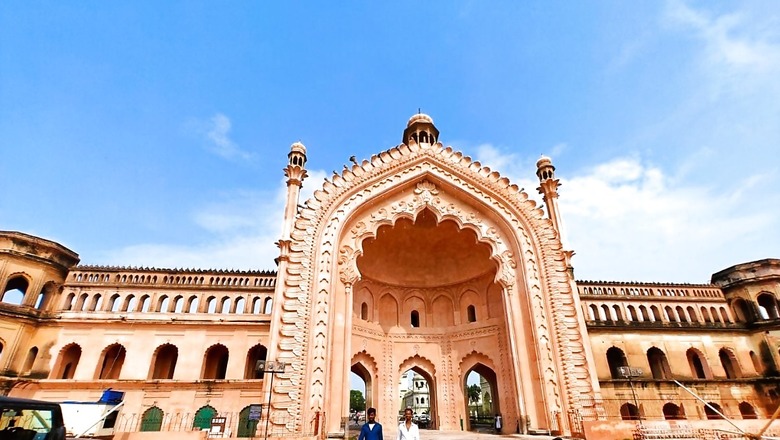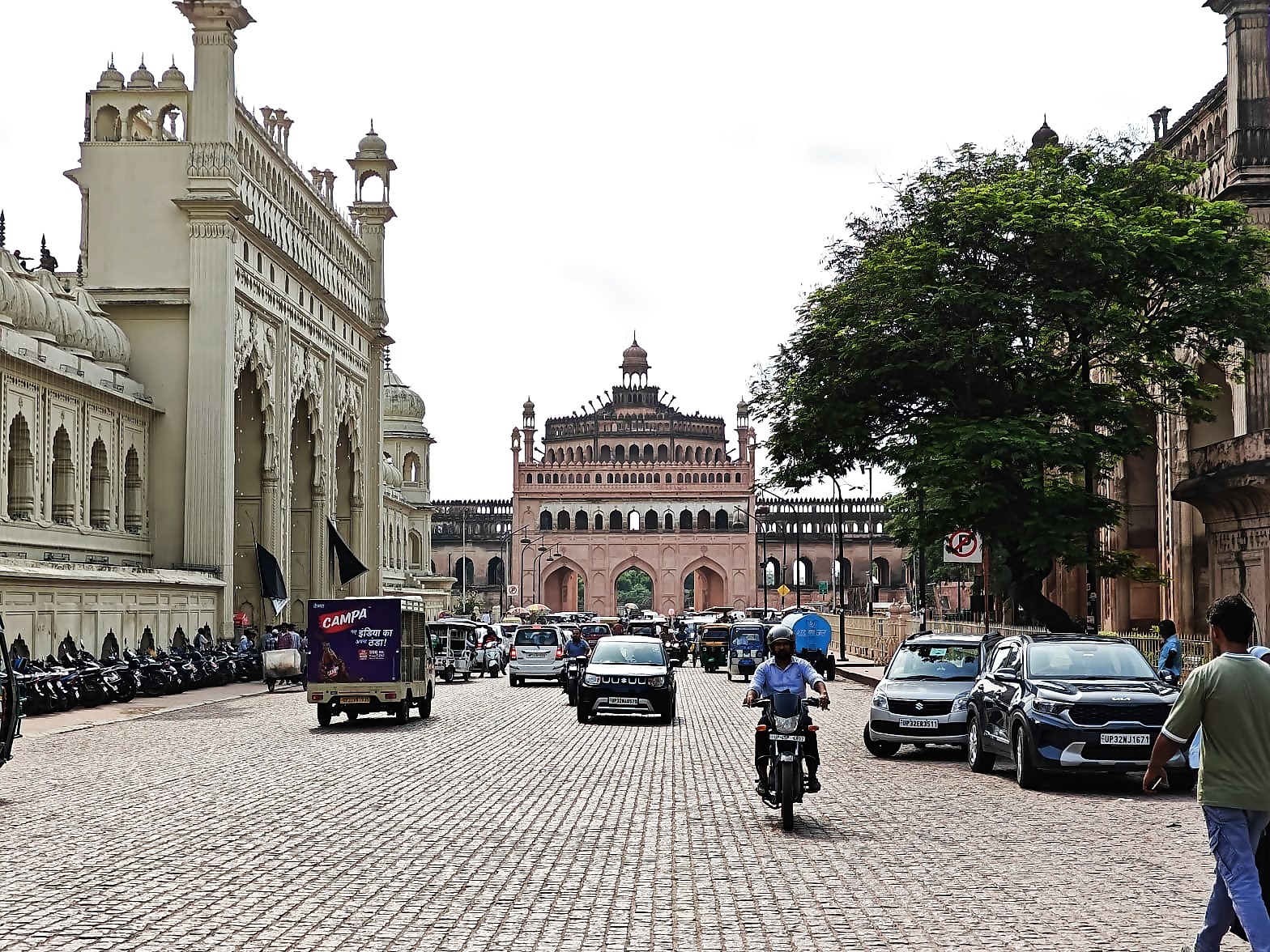
views
Sporting a clean, crisp look with a pinkish tone, probably due to a fresh plaster of ‘surkhi’, lime and mortar, the iconic Rumi Darwaza — one of the most sought-after heritage structures located in the historic Old City of Lucknow — continues to captivate visitors.
A testament to the architectural brilliance of the bygone era, the 80-feet-high Rumi Darwaza was built in 1784 by Nawab Asaf-Ud-Daula, the Nawab of Oudh, and reopened to the public recently after nearly two years of closure initiated by the Archaeological Survey of India (ASI) for essential maintenance and conservation work.
“Rumi Darwaza has been restored. Almost 99 per cent of the entire restoration work has been completed after which the structure was made open for the public, keeping in mind Muharram (as the gate falls on the route of the traditional Muharram procession). It took us nearly one-and-a-half years and about Rs 50 lakh to restore the giant multi-storeyed gate,” Aftab Hussain, superintending archeologist, Lucknow Circle, ASI, said.
However, ASI officials made it clear that traffic movement through the gates would remain restricted. “Traffic will remain banned as it was before, with vehicles being diverted to the adjacent road. This arrangement has been approved by the district administration to ensure the safety and preservation of the historic Rumi Darwaza.,” Hussain told News18.

The restoration of the iconic gate was not child’s play, say the team of archaeologists involved in the mammoth task of giving a fresh lease of life to the structure that was lying in ruins for the last five decades. In December 2022, the ASI undertook the task of restoring the architectural marvel after several gaping cracks surfaced on its walls.
“Restoring the Nawabi-era Rumi Darwaza was a unique challenge as the structure was in bad shape. There were gaping cracks in the structure, the plaster and the stucco work was coming off at many places. Hence, while carrying out the restoration process, we relied heavily on traditional construction methods to ensure that the newly constructed portion seamlessly assimilates with the original structure from the Nawabi era, ensuring a firm and durable grip. It was for the same reason that a basic material, including pulses, jaggery, ‘babool’ juice (used as adhesive), batasha (sugar sweet), eggs without the yolk, and fine jute were also used along with the mortar, lime and surkhi,” said Hussain.
The Process
Obtaining permission to restrict vehicular movement passing through the gate was the first step, Hussain said. “Once permission was granted by the district administration and traffic police, we began with the research and development part. We managed to procure the original pictures of the heritage structure in order to give it the original look and a team of experts minutely studied the pictures and other documents related to the structure. The entire process took almost three to four months,” the ASI officer recollected.
He said this was followed by erecting iron scaffoldings in which over 1,000 pipes were used. After that, huge pits were dug up to prepare the traditional binding material, which turned out to be the ‘elixir’ for this 240-year-old architectural marvel. For the intricate floral designs and stucco work on the gate, the team meticulously took impressions of every motif using butter paper to ensure accuracy without altering the original design. This careful approach preserved the authenticity of Rumi Darwaza.
‘Stitching Cracks Was Most Crucial Task’
Over the years, the 240-year-old Rumi Darwaza had developed many cracks due to lack of maintenance and repairs. While filling cracks is usually straightforward for experts, they were puzzled by the fact that the cracks widened with every attempt to reach their root. This unexpected challenge made the restoration process more complex and required innovative solutions to preserve the structure’s integrity. “We used special stainless-steel clamps to stitch the cracks which was later covered with layers of plaster to give a uniform look to the surface,” Hussain said.
Most Vulnerable to Seismic Activity
In 2013, experts from the Department of Civil Engineering at the Indian Institute of Technology, Kanpur (IIT-K), identified Rumi Darwaza as the most vulnerable standing monument in Lucknow. This conclusion stemmed from a study conducted by Professor Durgesh C Rai and his team, who assessed the monument’s seismic load-carrying capacity. Their evaluation revealed that the seismic load capacity of the masonry arch structure was only 17 per cent of its weight, below the required 21 per cent, making it inadequate for the demands of seismic zone III, where it is located.

The study highlighted that apart from weather exposure, frequent vehicular movement through the gate had exacerbated the damage. The team of experts also carried out on-site ambient vibration testing, using sophisticated sensors and equipment placed at four different levels in both latitudinal and longitudinal directions. This testing showed that the structure’s excitations were primarily due to vehicular vibrations. The Complex Mode Indicator Function (CIMF) technique was used and a three-dimensional model of the monument was created using ABAQUS software to obtain accurate data.
The IIT-K team suggested that only high-quality restoration work could enhance the structure’s strength, making it resilient enough to withstand future seismic events.
Restoration A Hit
The restoration of Rumi Darwaza has brought a smile on the faces of heritage enthusiasts in Lucknow, who appreciated ASI’s work.
S Mohammed Haider, senior lawyer and heritage enthusiast, said Rumi Darwaza was declared a protected monument on in December 1920, vide notification No. UP 1645-M/1133. “Unfortunately, despite there being a clear mandate of law, the Rumi Darwaza was on the verge of collapse as a result of heavy vehicular movement through it, a concern which has been duly highlighted by us in our PIL which is pending with the Lucknow Bench of the Allahabad High Court.”
He added: “With our concerted efforts and a series of correspondences by the ASI, more particularly their letter dated 01.09.2022, to the district administration and the state government for providing an alternative route, the said request was finally heeded and restoration work of this magnificent edifice was started.”
He said the finials on the monument, which were damaged, would be repaired and restored within this financial year as confirmed by ASI. “We sincerely hope that the vehicular movement from the monument, which was stopped on account of its conservation, shall remain stopped to prevent any further damage to the monument,” he added.
The ASI has also planned an exhibition in February next year in order to showcase the entire restoration work and the efforts made to save the structure. Other than Rumi Darwaza, the exhibition will also highlight 22 other structures in UP that underwent conservation work.
















Comments
0 comment